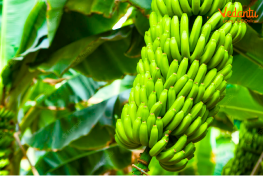Banana Trees : An Enthralling Poem on Banana Trees
Do you like to eat bananas? Maybe not! But have you ever taken a look at banana trees? They are not like most other trees, isn’t it? The banana plant is considered sacred among the Hindus and is worshipped as well. Often children fuss about eating bananas. However, parents can read out this amazing piece of poetry to their children and encourage them to appreciate this beautiful gift of nature. ‘Banana Trees’ by Joseph Stanton is a good read for children of all ages.
Kids, if you haven’t had a chance to see what a banana tree looks like, here’s a picture for you.

Banana Trees
Banana Trees - by Joseph Stanton
They are tall herbs, really, not trees,
Though they can shoot up thirty feet
If all goes well for them.
Cut in cross-section, they look like gigantic onions,
Multi-layered mysteries with ghostly hearts.
Their leaves are made to be broken by the wind,
If wind there be, but the crosswise tears
They are built to expect do them no harm.
Around the steady staff of the leafstalk
The broken fronds flap in the breeze
Like brief forgotten flags, but these
Tattered, green, photosynthetic machines
Know how to grasp with their broken fingers
The gold coins of light that give open air
Its shine. In hot, dry weather the fingers
Fold down to touch on each side--
A kind of prayer to clasp what damp they can
Against the too much light.
Summary
This poem on banana trees by the Hawaiian poet, Joseph Stanton, compels us to view banana trees in a way we usually don’t consider or bother to. Stanton’s job as a professor at the University of Hawaii in Manoa had probably brought him across several banana plantations as they are widely available there. From the very beginning of the poem, Stanton renders a mystic appeal to the banana trees. He says that they are not like ordinary trees but herbaceous in nature; herbs that can grow up to 30 feet if well nourished. Moreover, he refers to them as gigantic onions, composed of multiple layers of mysteries “with ghostly hearts”.
Stanton then goes on to describe the huge leaves of the banana plant. They appear unaffected by the tears caused to them by the wind. The poet views the torn banana leaves, flapping from the staff in the wind, as small neglected flags that keep fluttering in the breeze. He then alludes to the process of photosynthesis carried out by the plants by calling the leaves “photosynthetic machines”. These tattered flag-like leaves are personified as broken fingers that grab “gold coins of light” or sunlight required for photosynthesis.
The poet further adds that on hot, dry days, the wilted banana leaves droop and form, what appears to be, hands folded in prayer on each side of the stem, in search of damp to protect themselves from the unbearable light and heat of the sun. A remarkable poetic device used in this poem is run-on lines. This feature results in a continuous flow of the lines and enhances the poet’s idea of the banana trees. Stanton’s meticulous observation and description of the trees in this poem on banana trees changes the way readers would view this plant and ensures that we never look at them the same way ever again.
About Joseph Stanton
Born in the year 1949, Joseph Stanton is a renowned poet, writer, historian, and baseball fan. He is a teacher of Art History and American studies at the University of Hawai‘i in Mānoa. In 1997, Stanton was awarded the Cades Award for his contributions to the literature of Hawai‘i. As an art historian, Stanton has to his credit essays on Edward Hopper, Winslow Homer, Maurice Sendak, Chris Van Allsburg, and several other artists. His love for art can be discovered in the scholarly text on the artwork of children's storybooks written by him that comprises artists like Sendak and Van Allsburg among others.
Some of Joseph Stanton’s famous poetic pieces include A Field Guide to the Wildlife of Suburban O‘ahu, Cardinal Points, Imaginary Museum: Poems on Art and What the Kite Thinks. Furthermore, his remarkable non-fiction works comprise The Important Books: Children’s Picture Books as Art and Literature and Stan Musial: A Biography.
When we plant one banana tree a few more start growing right beside it on their own. If we cut them down and leave a little bit of the stalk, they will grow into a full-fledged tree soon. In some Indian communities, the entire banana tree is used up. Other than eating ripe bananas, they use the leaves of the plant as plates or to wrap food, cook delicious food from banana flowers, stalks, and raw bananas.


FAQs on A Poem on Banana Trees for Kids
1. How does the poet describe the banana leaves in the poem Banana Trees?
In the poem Banana Trees, Joseph Stanton refers to the tattered leaves hanging from the leafstalk and torn by the wind as forgotten and neglected small flags that flutter when the wind blows. He further visualises them as broken fingers that grab sunlight for photosynthesis similar to hands grabbing coins. In dry and hot weather, their droopy and withered state resembles hands folded in prayer, which seek dampness and shade from the strong light.
2. State any three comparisons made by the poet in the poem.
In the second stanza of the poem, the poet renders the banana trees a mystic appeal when he compares them to gigantic onions with multiple layers of mystery and ghostly hearts. Towards the end, he makes a comparison between forgotten flags and the tattered state of the torn banana leaves. Finally, he personifies them as broken fingers grabbing golden coins, which is sunlight, and praying in their wilted state for dampness. These are the three comparisons mentioned in the poem.





